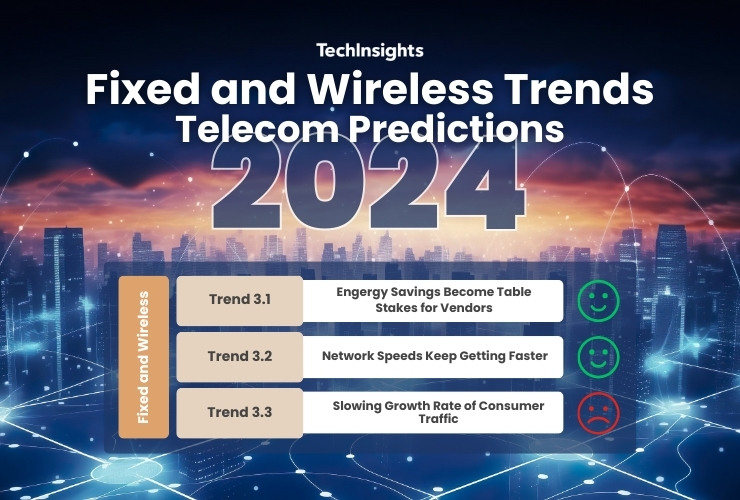2024 Fixed and Wireless Trends
Fixed and Mobile Network Operators/Vendors Look Ahead to 2024 and Beyond
2023 was a year of retrenchment in the telecom ecosystem, against a backdrop of high inflation, high interest rates, macro-economic jitters, lingering high energy prices and geopolitical tensions. Operators drew back from the record capex spending of the 2020-2022 period, influenced by financial pressures, investor sentiment, inventory corrections, and achievement of deployment milestones. In addition, the scope of new deployments was reduced due to inflation, high interest rates and labor shortages.
Slower spending could start to improve by the end of 2024, with lower interest rates, moderating inflation, and inventories returning to normal levels. Late in 2024, growth is likely to strengthen in the fixed broadband access space, as many operators race toward deployment milestones that are set to occur in 2025 and 2026. Similarly, the mobile infrastructure space may be set for modest improvement, on revenue expectations for 5G Advanced.
In addition to tracking what’s behind the business cycles of the various segments, TechInsights sees three major trends that will affect the trajectory of the industry over the next several years.
Energy Efficiency is Even More Urgent
First, the 2022 energy price shocks brought home to operators the business risks of high energy prices. The industry had been focused on energy savings primarily for reduction of Scope-2 carbon emissions. Natural gas price spikes triggered by geopolitical events negatively affected operators' financial results, and thus brought even greater urgency to the subject. As a result, operators have increased pressure on equipment vendors to improve their energy efficiency, making it a critical criterion in vendor selection. Vendors have responded with impressive innovations in energy efficiency, along with market messaging focused on energy savings. We have observed more frequent competing claims for “the industry’s lowest power consumption” in various equipment categories. We expect to see technology, product, and marketing focus on this topic to remain strong for at least the near future.
“In a world of energy price volatility, efficiency isn't just an option—it's a survival strategy. The urgency for energy efficiency has never been greater.”
Network Speeds Push Even Faster
One of the longest running trends in telecom and data comm has been a steady progression of higher data rates, as pushed by growing demands, and enabled by improving technology. The 2023-2025 timeframe will mark multiple milestones in this progression. In broadband access, nominal “10 Gigabit” (per second) is displacing nominal “Gigabit” in new network deployments and upgrades, as well as in operator’s consumer messaging and competitive offerings. This includes not only fiber, but also cable and, to a lesser extent, fixed wireless. In fiber access for enterprise, back-, mid-, and front-haul and fiber-to-the-building applications, 25- and 50- Gbit/s Passive Optical Network (PON) technologies are progressing into the early adoption and innovators phases of the technology cycle, respectively. Meanwhile, researchers and standards committees are pursuing the next higher speed PON. WiFi 7 officially launched in early 1Q24, and is picking up momentum, as a necessary complement to 10 Gigabit-class broadband.
Optical networking technology for transport networks and data center interconnect began another 4-year technology cycle in 2023, with vendor announcements and field trials of 1.2 and 1.6 Tbps wavelengths, while early adopters are deploying 800 Gbps networks, and the mainstream is in the middle of a shift from 100 to 400 Gbps. 5G Advanced brings further advances in attainable over-the-air speed and capacity, both in the recent 3GPP Rel. 18 and the upcoming Rel. 19. In addition, mobile fronthaul, midhaul and backhaul appears to be at the start of a shift from 10- and 25 Gbps transport to 100 Gbps. For PON and optical transport, the next logical step up in speed will have to surmount steep cost and technological barriers.
Get Your Free Download
Fill out the form below to download the FREE 2024 Fixed and Wireless Trends report.
Broadband Braces for Slower Growth Rate Era
Over the long term, the rate of growth in consumer broadband traffic has been slowing. TechInsights has been highlighting this trend since 2021 and challenging the prevailing view that historical traffic growth will continue indefinitely and so justify the development of ever faster networks. In a meta-trend, this idea is gaining traction in the industry, as increasing numbers of voices proclaim an end to “speed wars”. This trend will have a profound effect on industry business models in the long term. Most importantly, traffic growth will not trigger periodic cycles of network upgrades and higher speed tiers as it has in the past. Operators and their vendors will need to look elsewhere for revenue growth.










